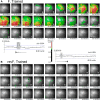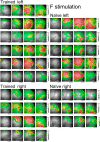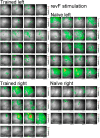Cortical Activation Patterns Evoked by Temporally Asymmetric Sounds and Their Modulation by Learning
- PMID: 28451640
- PMCID: PMC5399754
- DOI: 10.1523/ENEURO.0241-16.2017
Cortical Activation Patterns Evoked by Temporally Asymmetric Sounds and Their Modulation by Learning
Erratum in
-
Correction: Horikawa and Ojima. Cortical Activation Patterns Evoked by Temporally Asymmetric Sounds and Their Modulation by Learning (eNeuro March/April 2017, 4(2) e0241-16.2017 1-19 https://doi.org/10.1523/ENEURO.0241-16.2017).eNeuro. 2017 May 25;4(3):ENEURO.0169-17.2017. doi: 10.1523/ENEURO.0169-17.2017. eCollection 2017 May-Jun. eNeuro. 2017. PMID: 28560314 Free PMC article.
Abstract
When complex sounds are reversed in time, the original and reversed versions are perceived differently in spectral and temporal dimensions despite their identical duration and long-term spectrum-power profiles. Spatiotemporal activation patterns evoked by temporally asymmetric sound pairs demonstrate how the temporal envelope determines the readout of the spectrum. We examined the patterns of activation evoked by a temporally asymmetric sound pair in the primary auditory field (AI) of anesthetized guinea pigs and determined how discrimination training modified these patterns. Optical imaging using a voltage-sensitive dye revealed that a forward ramped-down natural sound (F) consistently evoked much stronger responses than its time-reversed, ramped-up counterpart (revF). The spatiotemporal maximum peak (maxP) of F-evoked activation was always greater than that of revF-evoked activation, and these maxPs were significantly separated within the AI. Although discrimination training did not affect the absolute magnitude of these maxPs, the revF-to-F ratio of the activation peaks calculated at the location where hemispheres were maximally activated (i.e., F-evoked maxP) was significantly smaller in the trained group. The F-evoked activation propagated across the AI along the temporal axis to the ventroanterior belt field (VA), with the local activation peak within the VA being significantly larger in the trained than in the naïve group. These results suggest that the innate network is more responsive to natural sounds of ramped-down envelopes than their time-reversed, unnatural sounds. The VA belt field activation might play an important role in emotional learning of sounds through its connections with amygdala.
Keywords: belt field; primary auditory field; sound discrimination; spatiotemporal activation; time-reversed sound; voltage-sensitive dye imaging.
Figures










Similar articles
-
Spatiotemporal dynamics of neural activity related to auditory induction in the core and belt fields of guinea-pig auditory cortex.Neuroreport. 2012 May 30;23(8):474-8. doi: 10.1097/WNR.0b013e328352de20. Neuroreport. 2012. PMID: 22473291
-
Response characteristics of primary auditory cortex neurons underlying perceptual asymmetry of ramped and damped sounds.Neuroscience. 2014 Jan 3;256:309-21. doi: 10.1016/j.neuroscience.2013.10.042. Epub 2013 Oct 28. Neuroscience. 2014. PMID: 24177068
-
How do auditory cortex neurons represent communication sounds?Hear Res. 2013 Nov;305:102-12. doi: 10.1016/j.heares.2013.03.011. Epub 2013 Apr 17. Hear Res. 2013. PMID: 23603138 Review.
-
A Hierarchy of Time Scales for Discriminating and Classifying the Temporal Shape of Sound in Three Auditory Cortical Fields.J Neurosci. 2018 Aug 1;38(31):6967-6982. doi: 10.1523/JNEUROSCI.2871-17.2018. Epub 2018 Jun 28. J Neurosci. 2018. PMID: 29954851 Free PMC article.
-
Hearing of modulation in sounds.Physiol Rev. 1982 Jul;62(3):894-975. doi: 10.1152/physrev.1982.62.3.894. Physiol Rev. 1982. PMID: 7045902 Review. No abstract available.
Cited by
-
Updates to the guinea pig animal model for in-vivo auditory neuroscience in the low-frequency hearing range.Hear Res. 2022 Oct;424:108603. doi: 10.1016/j.heares.2022.108603. Epub 2022 Sep 5. Hear Res. 2022. PMID: 36099806 Free PMC article.
-
Cystatin C promotes cognitive dysfunction in rats with cerebral microbleeds by inhibiting the ERK/synapsin Ia/Ib pathway.Exp Ther Med. 2020 Mar;19(3):2282-2290. doi: 10.3892/etm.2019.8403. Epub 2019 Dec 31. Exp Ther Med. 2020. PMID: 32104295 Free PMC article.
-
How far neuroscience is from understanding brains.Front Syst Neurosci. 2023 Oct 5;17:1147896. doi: 10.3389/fnsys.2023.1147896. eCollection 2023. Front Syst Neurosci. 2023. PMID: 37867627 Free PMC article.
References
-
- Akeroyd MA, Patterson RD (1995) Discrimination of wideband noises modulated by a temporally asymmetric function. J Acoust Soc Am 98:2466–2474. 10.1121/1.414462 - DOI
-
- Albert DJ, Petrovic DM, Walsh ML (1989) Competitive experience activates testosterone-dependent social aggression toward unfamiliar males. Physiol Behav 45:723–727. - PubMed
-
- Berryman JC (1976) Guinea-pig vocalizations: their structure, causation and function. Z Tierpsychol 41:80–106. - PubMed
MeSH terms
LinkOut - more resources
Full Text Sources
Other Literature Sources
